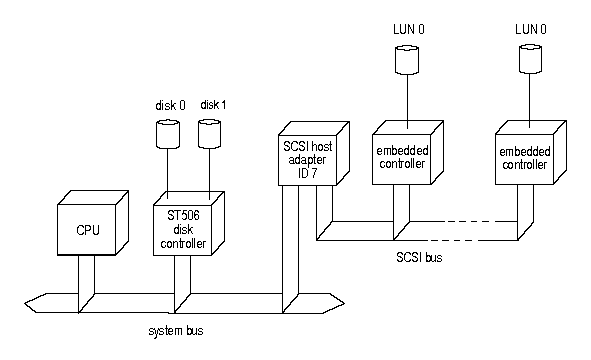Adding secondary hard disks
Here are some possible configurations for systems
containing multiple hard disks:
-
Root disk on the primary SCSI host adapter:
only other SCSI host adapters can be added.
Each host adapter, including the primary, is capable of
supporting up to seven disk drives with embedded controllers
on a SCSI-1 bus, and up to 15 on a 16-bit
Wide SCSI-2, Ultra-SCSI (SCSI-III),
or Ultra2SCSI bus.
-
Root disk on an IDE, EIDE, UDMA
or ESDI controller:
ISA, EISA, and MCA bus machines can
support up to two IDE, EIDE, or
UDMA controllers.
Each controller can support two disk drives.
SCSI host adapters can also be added and configured as shown in
``Example of a mixed ST506-interface disk controller and SCSI configuration''.
-
Root disk on a Compaq IDA-III controller:
a maximum of five more IDA-III controllers can be added.
Each controller can support 14 disk drives.
To install SCSI disks, first set up
the SCSI configuration files and link the correct
device drivers into the kernel using the Hardware/Kernel Manager
or mkdev hd as described in
``Configuring a SCSI hard disk''.
Then proceed to
``Installing a hard disk'',
where you invoke the same command a second time
to partition the disk and make the filesystems.
To install USB disks, see
``Configuring a USB hard disk'',
then proceed to
``Installing a hard disk''.
To install IDE disks, see
``Configuring IDE disks and disk controllers''
then follow the procedure described in
``Installing a hard disk''.
To install EIDE, UDMA, ESDI,
or IDA disks, follow the procedure described in
``Installing a hard disk''.

Example of a mixed ST506-interface disk controller and SCSI configuration
NOTE:
Configure the hardware according to the
documentation provided with your machine.
EISA bus machines have a configuration utility to do this;
ISA machines require you to change jumper settings
on the hardware.
SCSI hard disks must have the correct target
ID set on their controller card. The SCSI
bus must also be correctly terminated at both ends.
Ensure that the additional drive is formatted and
passes the manufacturer's diagnostic tests before
installing the system. If it does not pass the diagnostic
tests, you should not use it with your system.
Next topic:
Configuring a SCSI hard disk
Previous topic:
Supported hard disk configurations
© 2003 Caldera International, Inc. All rights reserved.
SCO OpenServer Release 5.0.7 -- 11 February 2003

